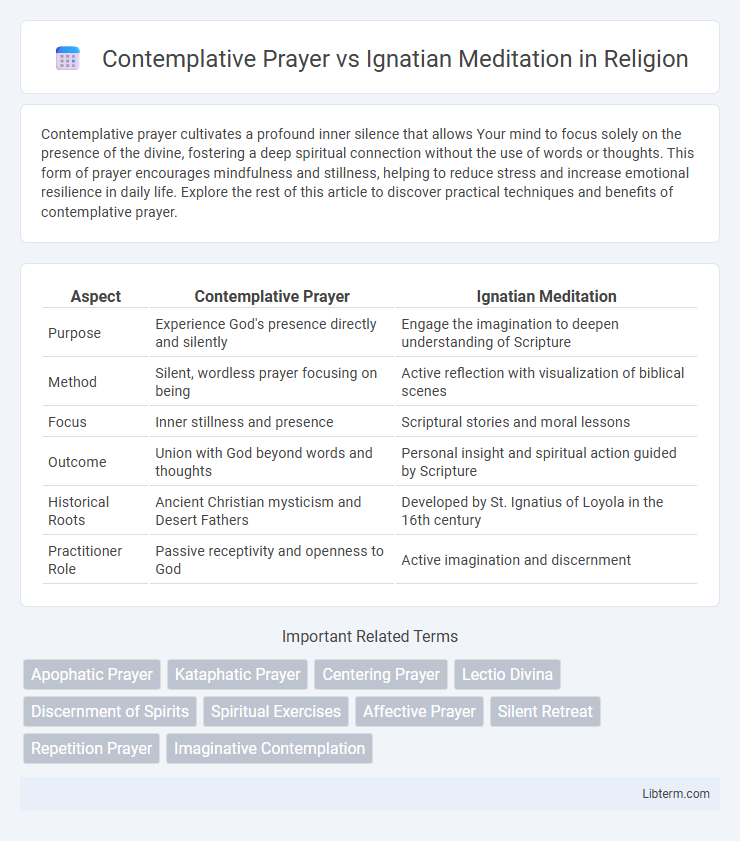Contemplative prayer cultivates a profound inner silence that allows Your mind to focus solely on the presence of the divine, fostering a deep spiritual connection without the use of words or thoughts. This form of prayer encourages mindfulness and stillness, helping to reduce stress and increase emotional resilience in daily life. Explore the rest of this article to discover practical techniques and benefits of contemplative prayer.
Table of Comparison
| Aspect | Contemplative Prayer | Ignatian Meditation |
|---|---|---|
| Purpose | Experience God's presence directly and silently | Engage the imagination to deepen understanding of Scripture |
| Method | Silent, wordless prayer focusing on being | Active reflection with visualization of biblical scenes |
| Focus | Inner stillness and presence | Scriptural stories and moral lessons |
| Outcome | Union with God beyond words and thoughts | Personal insight and spiritual action guided by Scripture |
| Historical Roots | Ancient Christian mysticism and Desert Fathers | Developed by St. Ignatius of Loyola in the 16th century |
| Practitioner Role | Passive receptivity and openness to God | Active imagination and discernment |
Introduction to Contemplative Prayer and Ignatian Meditation
Contemplative Prayer centers on silent presence and open awareness of God beyond words, fostering a deep spiritual connection through interior stillness. Ignatian Meditation involves imaginative engagement with Scripture, encouraging active reflection and discernment to encounter God's guidance in daily life. Both practices offer distinct pathways to spiritual growth, emphasizing experiential knowledge and personal transformation.
Historical Origins and Spiritual Contexts
Contemplative prayer originates from early Christian monastic traditions, emphasizing silent, wordless communion with God, particularly rooted in the Desert Fathers' spiritual practices. Ignatian meditation, developed by St. Ignatius of Loyola in the 16th century, integrates imaginative engagement with Scripture to foster active discernment and personal transformation. The spiritual context of contemplative prayer centers on interior stillness and union with the divine presence, while Ignatian meditation focuses on reflective participation and applying Gospel insights to daily life decisions.
Core Philosophies and Theological Foundations
Contemplative Prayer centers on silent, receptive communion with God, emphasizing interior stillness and the experience of divine presence rooted in the mystical traditions of Christian spirituality. Ignatian Meditation, founded by St. Ignatius of Loyola, employs imaginative engagement with Scripture, encouraging active reflection and discernment to foster personal transformation and alignment with God's will. Both practices share a theological foundation in seeking deeper union with Christ, yet Contemplative Prayer prioritizes passive contemplation while Ignatian Meditation focuses on active, imaginative participation in biblical scenes.
Structure and Practice: How Each Method Works
Contemplative prayer emphasizes silent, wordless presence with God, focusing on interior stillness and receptivity without structured dialogue or guided imagery. Ignatian meditation involves active reflection on scripture or themes through imaginative engagement, often using sensory details to deepen personal connection and insight. Both methods cultivate spiritual growth but differ in practice: contemplative prayer centers on passive openness, while Ignatian meditation employs deliberate mental exercises and imaginative contemplation.
Goals: Union with God vs. Discernment and Reflection
Contemplative prayer aims for deep union with God through silent, loving presence, fostering an intimate spiritual connection beyond words. Ignatian meditation focuses on discernment and reflection by engaging the imagination and intellect to understand God's will and make thoughtful decisions. Both practices enhance spiritual growth but differ in method and ultimate goal--experiencing divine union versus active spiritual insight.
The Role of Silence and Imagination
Contemplative prayer emphasizes deep silence as a path to encounter the divine presence beyond thoughts, fostering an interior stillness that transcends verbal expression. Ignatian meditation actively engages the imagination to visualize Gospel scenes, inviting the practitioner to enter the narrative through sensory details and emotional reflection. The interplay of silence in contemplative prayer contrasts with the imaginative stimulation of Ignatian meditation, highlighting distinctive spiritual practices rooted in stillness versus active visualization.
Benefits and Spiritual Fruits of Each Practice
Contemplative prayer fosters deep inner peace and heightened spiritual awareness by encouraging silent receptivity to God's presence, promoting humility and unconditional love. Ignatian meditation engages the imagination and intellect through guided reflection on Scripture, enhancing discernment, emotional insight, and active decision-making aligned with divine will. Both practices cultivate spiritual fruits such as patience, compassion, and strengthened faith, yet contemplative prayer nurtures profound union with God, while Ignatian meditation equips believers for purposeful action in daily life.
Common Misconceptions and Clarifications
Contemplative prayer is often mistaken for simply emptying the mind, but it emphasizes silent communion with God, fostering inner stillness and presence without active visualization or scripture analysis common in Ignatian meditation. Ignatian meditation involves imaginative engagement with biblical scenes, inviting the meditator to enter the narrative and experience spiritual insights, contrasting with the receptive, wordless nature of contemplative prayer. Clarifying these distinctions helps practitioners choose approaches aligning with their spiritual goals, avoiding confusion between active reflection and passive contemplation.
Integrating Both Practices in Personal Spirituality
Integrating contemplative prayer and Ignatian meditation enhances personal spirituality by blending silent presence with active reflection on Scripture and life experiences. Contemplative prayer cultivates deep inner stillness and awareness of God's presence beyond words, while Ignatian meditation invites imaginative engagement and discernment through guided visualization and emotional responses. Combining both practices fosters holistic spiritual growth, balancing quiet receptivity with dynamic interaction, enriching one's relationship with the divine.
Choosing the Right Approach for Your Spiritual Journey
Contemplative Prayer emphasizes silent presence and surrender to experience God's love deeply, fostering inner peace and spiritual receptivity. Ignatian Meditation involves active imagination and reflection on Scripture, engaging the mind and emotions to discern God's will and personal growth. Selecting the right approach depends on whether you seek contemplative stillness to deepen union with God or dynamic engagement for spiritual insight and decision-making.
Contemplative Prayer Infographic

 libterm.com
libterm.com